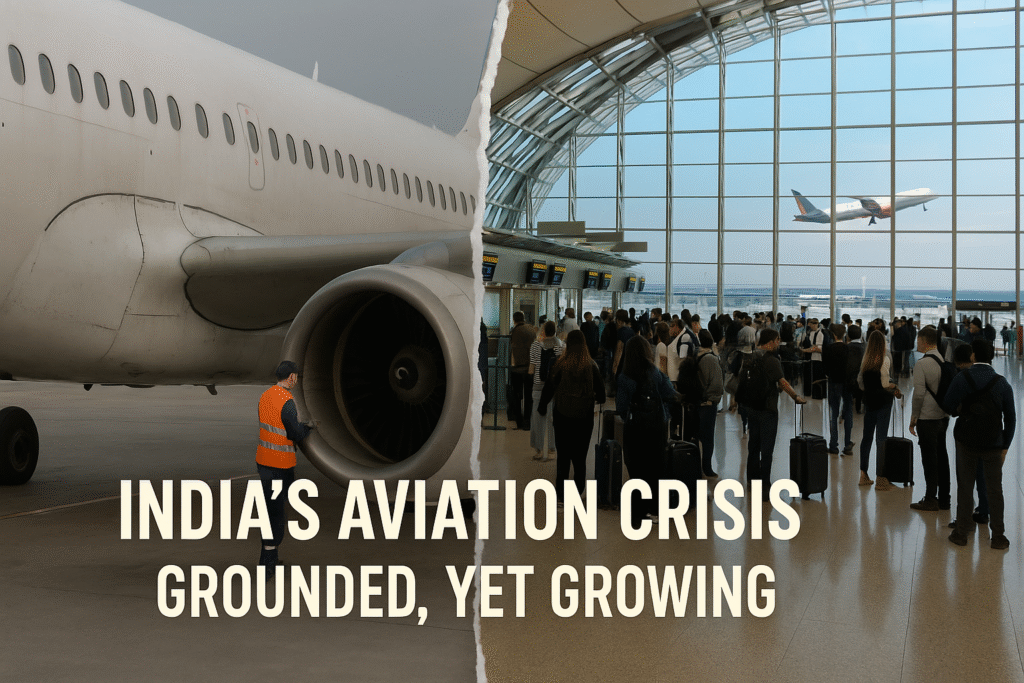India’s Aviation Sector: Soaring High but Struggling to Stay Airborne
India’s aviation industry is currently flying through rough weather. While passenger numbers are booming and new airports are popping up across the country, major challenges like supply chain delays, engine issues, and staff shortages are dragging down growth and profitability.
Engine Troubles and Grounded Flights
According to a report by the Investment Information and Credit Rating Agency (ICRA), airlines in India are increasingly struggling with engine failures—especially those using Pratt & Whitney (P&W) engines. These problems have forced multiple aircraft to be grounded, affecting flight schedules and overall efficiency.
With these engine-related setbacks, it’s becoming harder for airlines to maintain smooth operations, even as more people take to the skies post-COVID.
Supply Chain Disruptions: The Hidden Enemy
One of the biggest challenges right now is the global supply chain. Airlines are experiencing delays in receiving new aircraft and essential components. This delay affects their ability to increase fleet size and meet rising demand.
Key Effects:
- Aircraft Delivery Delays: Airlines are waiting longer to receive new planes, which means they can’t grow fast enough.
- Rising Operating Costs: The price of spare parts and technical labour is going up, which squeezes airline profits.
Staff Shortage: The Human Factor
Another serious issue plaguing the sector is a shortage of skilled staff. From pilots and cabin crew to maintenance teams and air traffic controllers—there’s a gap almost everywhere.
Areas Most Affected:
- Pilots: A shortage is leading to cancelled flights and increased pressure on existing pilots.
- Cabin Crew: Fewer crew members mean delays, poor service, and unhappy passengers.
- Ground Staff: Slow baggage handling and delayed boarding due to low staff strength are becoming common.
- Maintenance Technicians: Fewer technicians mean aircraft stay grounded longer for repairs.
- Air Traffic Controllers: A shortage here can disrupt the entire airspace schedule, leading to congestion and delays.
Many of these problems stem from the post-pandemic surge in travel and an aging workforce that’s either retiring or burning out.

Heavy Dependence on Imports
Another big concern is how much India relies on imported aviation goods. Most aircraft, engines, and spare parts are bought from other countries. This dependency makes the industry vulnerable to price changes, shipping delays, and geopolitical tensions.
Why This Import Dependence Exists:
- High-Tech Requirements: India still lacks the advanced manufacturing needed for key aviation parts.
- Cheaper Abroad: Buying in bulk from global manufacturers is often more cost-effective than building locally.
- Lack of Infrastructure: India needs more investment in R&D, skilled labour, and world-class production hubs.
- Global Supply Chains: Even global aviation giants depend on a web of suppliers, which makes full self-reliance difficult.
Growth is Still in Sight
Despite all these problems, India’s aviation industry is not slowing down completely. In fact, it continues to grow in several areas, thanks to strong government support and rising demand from a growing middle class.
Fast Facts:
- Global Ranking: India has become the third-largest domestic aviation market in the world, overtaking the UK. It’s expected to become the third-largest overall air passenger market by 2030.
- Airport Expansion: The number of operational airports in India has more than doubled. The government aims to reach 350–400 airports by 2047.
- Passenger Traffic: Domestic flyers have more than doubled over the last decade. International travel is also climbing steadily.
The Road Ahead: Challenges vs Opportunities
While India’s aviation sector has big dreams, it needs to solve its biggest headaches first. Fixing supply chain issues, training more staff, and reducing import dependence are critical steps. There’s also a need for better coordination between private airlines and government bodies to make flying smoother for everyone.
But with rising passenger demand, ongoing airport development, and a booming economy, the industry still has massive potential. If India can sort out its internal turbulence, it might just become the global aviation leader it’s aiming to be.
Final Word
India’s aviation sector is like a jet engine—it’s powerful but needs regular care to keep flying high. Addressing its core issues now will decide whether it can take off into a truly global leadership position or stay stuck in an endless cycle of delays and disruptions.
By Himansh Kumar | June 13, 2025






